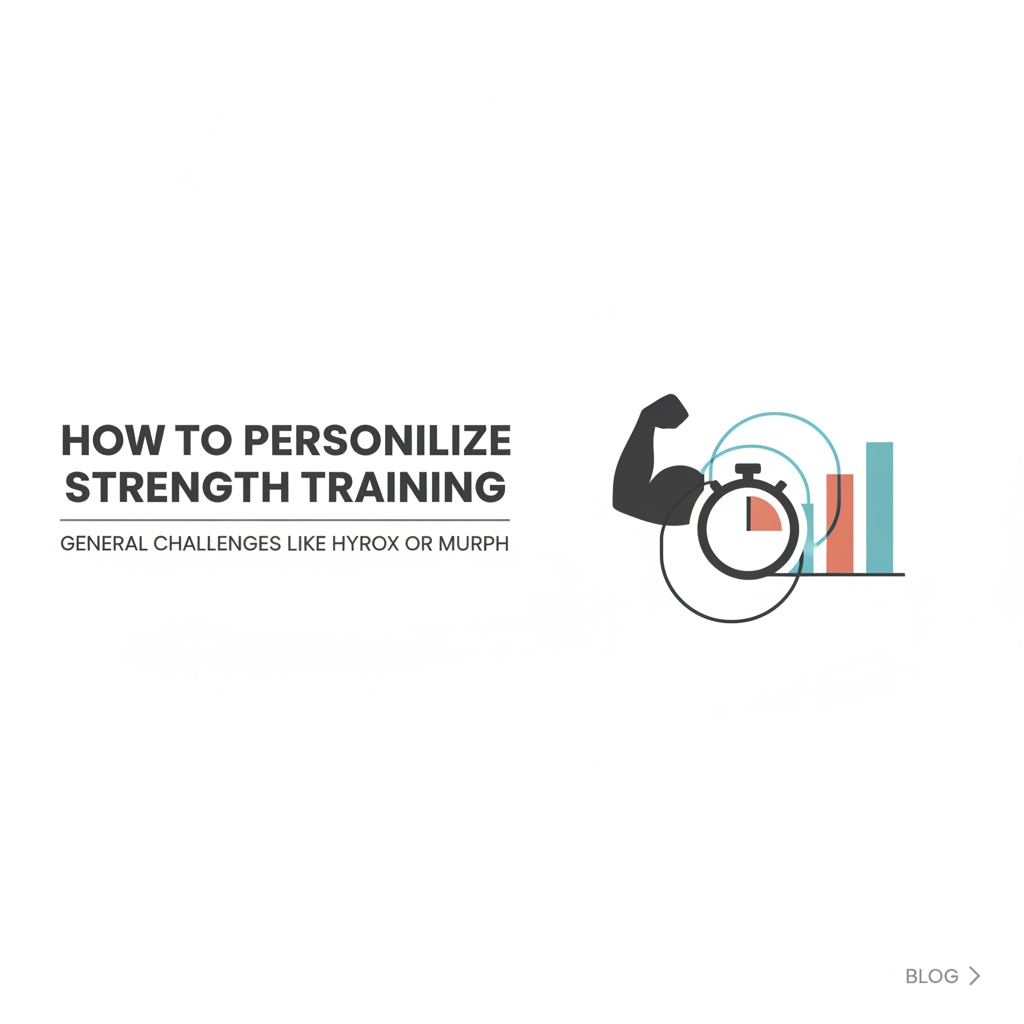How to Personalize Strength Training When Following General Challenges Like Hyrox or Murph

Let's be real – challenges like Hyrox and Murph are everywhere these days, and for good reason. They're exciting, they push you out of your comfort zone, and there's something undeniably motivating about having a clear goal to train toward. But here's the thing: just because these challenges come with a standardized format doesn't mean your training approach should be cookie-cutter.
If you've been wondering how to make these general programs work for YOUR specific situation, strengths, and goals, you're in the right place. Let's dive into how you can take these popular challenges and make them work for you, not against you.
Why One-Size-Fits-All Doesn't Work
Think about it – when you see a Hyrox training plan online or hear someone talking about their Murph prep, are they the exact same age, fitness level, and training background as you? Probably not. Yet somehow we expect the same generic approach to work for everyone.
Your current fitness level, training history, available time, and even your personal preferences all matter. A lot. Someone coming from a pure strength background is going to need a completely different approach than someone who's been running marathons for years. And that's perfectly okay!

The beauty of personalizing your approach is that you can actually get better results in less time because every workout is designed specifically for where you are and where you want to go.
Start With an Honest Assessment
Before you jump into any training plan, you need to know where you're starting from. This isn't about being perfect – it's about being honest with yourself so you can make smart decisions.
Assess Your Current Strengths
- Are you already strong but lacking endurance?
- Do you have great cardio but struggle with heavy carries?
- Are you comfortable with all the movement patterns, or do some feel foreign?
Identify Your Weak Points
- What movements make you cringe when you see them programmed?
- Where do you typically slow down or break form first?
- What energy system feels most challenging for you?
Consider Your Lifestyle Factors
- How many days per week can you realistically train?
- Do you have access to all the equipment you need?
- What's your current stress level and recovery capacity?
This assessment isn't meant to discourage you – it's your roadmap for making smart training decisions.
Smart Personalization Strategies
Adjust the Timeline
Not everyone needs to peak for the same event or follow the same preparation timeline. If you're newer to hybrid training, give yourself more time to build the aerobic base and movement proficiency. If you're already well-conditioned, you might be able to use a more aggressive approach.
Scale the Volume
Just because a program calls for five training days doesn't mean that's right for you. Maybe you can only commit to three days, or maybe you can handle six. The key is being consistent with whatever schedule you choose rather than constantly missing sessions because you bit off more than you can chew.

Modify Movement Patterns
Got a cranky shoulder that doesn't love overhead work? There are ways to work around that while still building the capacity you need. Bad knees that don't appreciate high-impact running? We can substitute other cardio modalities while still developing the right energy systems.
Adjust Intensity Distribution
This is where understanding your starting point really pays off. If you're coming from a strength background, you probably need more aerobic base work and less high-intensity training initially. If you're a cardio athlete, you might need to spend more time building strength endurance and power.
Actionable Personalization Tips
1. Create Your Own Benchmarks
Don't just track the official challenge metrics. Create intermediate benchmarks that matter for your specific situation. Maybe that's being able to complete all the movements without modification, or hitting certain time splits, or maintaining form for the full duration.
2. Use the 80/20 Rule
Spend 80% of your training time working on your weaknesses and 20% maintaining your strengths. This prevents you from getting worse at what you're already good at while making meaningful improvements where you need them most.
3. Build Progressive Overload Into Hybrid Training
You don't abandon progressive overload principles just because you're not doing traditional strength training. You can still progressively increase volume, density, or complexity over time. Maybe that means longer work periods, shorter rest periods, or combining more movements in a single session.

4. Practice Transitions
One thing that often gets overlooked in general programs is transition practice. The time you spend getting from one exercise to another, setting up equipment, or mentally shifting gears all matters in these challenges. Build this into your training.
5. Develop Multiple Energy System Pathways
Instead of just doing long slow cardio or short intense intervals, train across the entire spectrum. This might mean tempo runs, threshold work, VO2 max intervals, and aerobic base building all in the same training week.
6. Include Specificity Without Losing Variety
You want to practice the specific movements and demands of your chosen challenge, but you don't need to do the exact workout every single session. Use variations that train the same energy systems and movement patterns while keeping things interesting.
7. Plan Your Periodization
Break your training into phases that build logically toward your goal. Maybe you start with a base-building phase, progress to a strength-endurance phase, then finish with a competition-specific phase. Each phase should have clear objectives and appropriate training methods.
Listen to Your Body (It's Smarter Than Any Program)
Here's something that doesn't get talked about enough: your body will tell you how the personalization is working. Are you sleeping well? Do you feel energized for training sessions? Are you making progress toward your benchmarks? Are you enjoying the process?
If the answer to any of these is consistently "no," it's time to adjust your approach. Maybe you need more recovery time, different training stimuli, or simply a mental break from high-intensity work.

Making It Work Long-Term
The best personalized program is one you can stick with consistently. That means being realistic about your schedule, choosing approaches you actually enjoy, and building in flexibility for when life gets in the way.
Remember, these challenges are supposed to enhance your life and fitness, not take over completely. If your training is causing more stress than benefit, or if you're constantly struggling to fit everything in, it's time to reassess and adjust.
The goal isn't to follow someone else's program perfectly – it's to use these structured challenges as a framework for becoming the strongest, fittest version of yourself. When you approach it this way, you're not just preparing for one event; you're building sustainable habits and capacities that will serve you for years to come.
Your journey with challenges like Hyrox or Murph should feel challenging but doable, structured but flexible, and ultimately rewarding. When you take the time to personalize your approach, you set yourself up not just for success in the challenge, but for long-term growth in your fitness journey.
At Florence Strength and Conditioning, we believe every athlete deserves a training approach that works for their unique situation. These popular challenges can be incredible tools for growth when you take the time to make them truly yours.

Comments
Post a Comment